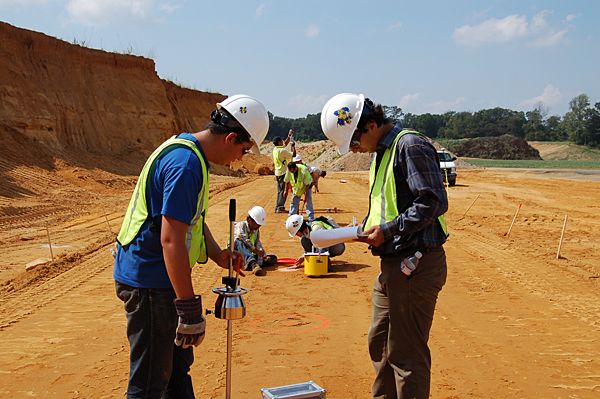Civil Geotechnical Engineering Services for Commercial and Residential Projects
Wiki Article
A Comprehensive Evaluation of the Providers Supplied by Consulting Engineers in the Area of Geotechnical Engineering: From Website Examination to Task Execution
Consulting designers in geotechnical design play a crucial function in the successful implementation of construction tasks, beginning with comprehensive site investigations that disclose crucial subsurface problems. Their know-how prolongs to dirt residential property analyses, environmental effect evaluations, and the careful monitoring of project implementation, ensuring alignment with safety and sustainability standards.Value of Geotechnical Design
Geotechnical design is an important technique that underpins the safety and sustainability of civil facilities jobs. By understanding the mechanical habits of soil and rock materials, geotechnical engineers evaluate the suitability of sites for different building and constructions, consisting of buildings, bridges, and dams. This essential evaluation makes certain that frameworks can stand up to ecological variables and lots without experiencing failing.The significance of geotechnical design expands beyond mere architectural safety; it likewise encompasses ecological stewardship. Proper geotechnical assessments add to reducing the eco-friendly influence of building. Through careful analysis of soil properties and groundwater conditions, engineers can design foundations and keeping structures that alleviate risks such as erosion and landslides, advertising lasting stability.
In addition, geotechnical design plays an essential duty in task price monitoring. geotechnical works. By determining possible issues early in the layout stage, engineers can recommend proper options, hence avoiding pricey delays and redesigns during construction. This proactive approach not only improves project performance however also considerably lowers dangers connected with unforeseen site problems
Site Investigation Techniques
Efficient website investigation methods are crucial for gathering precise information concerning subsurface problems prior to construction. These methods help with the understanding of the geological and hydrological atmosphere, which is important for ensuring the stability and safety of proposed structures.Typical approaches employed in site investigations include borehole exploration, which allows engineers to remove dirt samples at different depths, providing insights right into stratification and product kinds. In addition, geophysical studies, such as seismic refraction and electric resistivity, deal non-invasive means to evaluate subsurface characteristics over larger locations. These methods can assist recognize abnormalities without considerable excavation.
Test pits are another valuable strategy, giving straight monitoring of dirt layers and enabling in-situ testing. geotechnical works. This strategy is especially valuable for superficial excavations and can assist assess groundwater levels. Additionally, cone penetration tests (CPT) are progressively utilized, as they supply continuous profiles of dirt resistance, which aids in determining soil stamina and layering.
Each of these strategies plays an essential role in developing a thorough understanding of site problems, allowing consulting engineers to make informed decisions and referrals throughout the project lifecycle. Exact information collection throughout the website examination stage is crucial to mitigating risks and making certain successful project execution.
Soil Property Assessment

The evaluation process commonly entails a mix of research laboratory examinations and area investigations. Key buildings such as shear strength, compressibility, leaks in the structure, and moisture content are examined to determine the dirt's viability for construction purposes. Common tests, consisting of the Atterberg restrictions, Proctor compaction, and triaxial shear examinations, are generally utilized to collect information on soil habits.
Along with these tests, in-situ techniques such as the Standard Infiltration Examination (SPT) and Cone Penetration Test (CPT) provide useful insights right into soil stratigraphy and thickness. The results of these assessments educate engineers regarding possible obstacles, such as dirt liquefaction or negotiation, enabling them to devise appropriate reduction strategies.
Environmental Impact Assessment
Ecological effect examination plays a vital function in the planning and implementation of engineering projects, particularly in geotechnical engineering. This procedure involves assessing the prospective environmental repercussions of suggested tasks on soil, water, air quality, and surrounding ecosystems. Consulting designers use numerous approaches, consisting of site evaluations, modeling, and field researches, to determine and quantify these effects.The assessment typically begins with the recognition of standard ecological problems, which offers as a reference for predicting potential changes. Designers analyze factors such as disintegration, groundwater contamination, and environment disturbance, ensuring that all pertinent environmental laws and guidelines are complied with throughout the project lifecycle. Stakeholder involvement is additionally an indispensable component of the examination process, as it fosters communication between task designers, neighborhood neighborhoods, and regulative bodies.
Moreover, reduction techniques are developed to attend to determined effects, permitting engineers to suggest alternatives or alterations to project layouts that enhance consulting civil engineering companies sustainability. This positive technique not only reduces damaging impacts on the environment yet additionally advertises public trust and conformity with environmental regulations. Ultimately, reliable ecological effect assessment strengthens the overall honesty and practicality of geotechnical engineering jobs, sustaining accountable development methods.
Task Application and Monitoring

Tracking is a necessary part of job implementation. Engineers utilize different methods, such as instrumentation and field tests, to analyze soil behavior and structural actions in real-time. This constant surveillance allows the recognition of any kind of discrepancies from anticipated performance, enabling prompt treatments to reduce risks.
Moreover, getting in touch with engineers keep open communication with contractors and stakeholders throughout the process. Routine site assessments and report card make certain that all parties are educated about job status and any kind of arising issues. By cultivating cooperation and openness, seeking advice from designers promote an extra reliable application process, thereby enhancing job end results.
Ultimately, reliable job execution and tracking not only promote security and quality standards yet also add to the general success of geotechnical jobs, ensuring they meet their designated functions sustainably and responsibly.

Verdict
In verdict, the function of getting in touch with engineers in geotechnical design incorporates an essential series of services that make sure task success. Inevitably, the multifaceted payments of speaking with engineers are vital in attending to the intricacies of geotechnical difficulties in modern design tasks.Report this wiki page